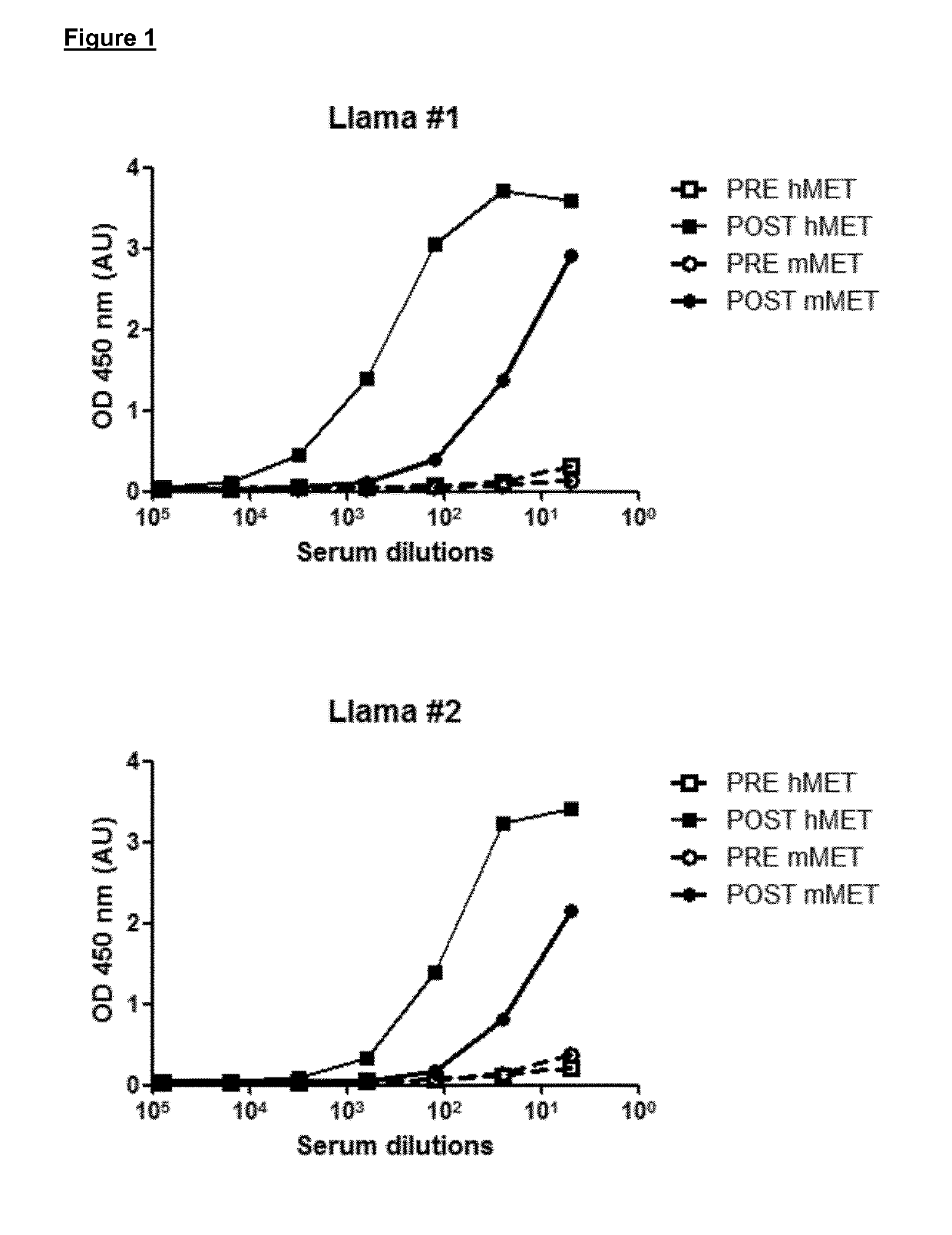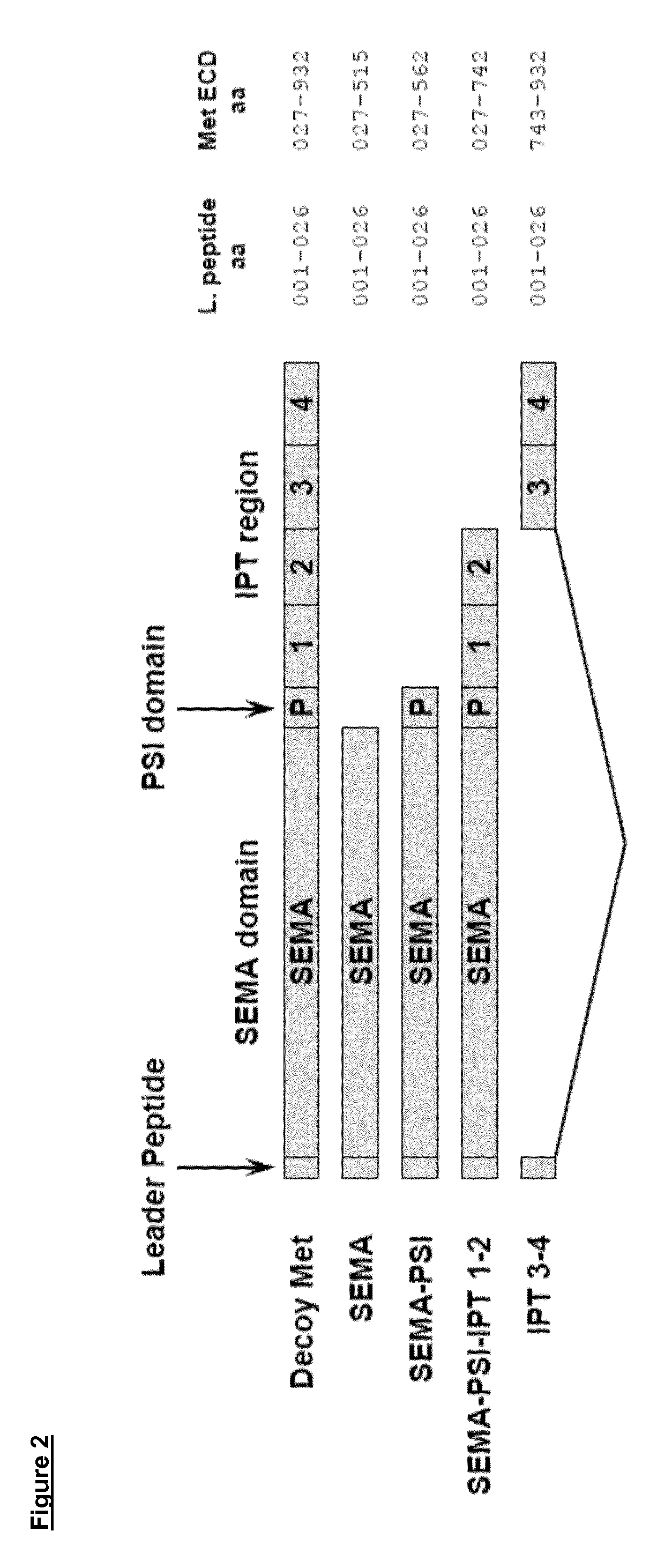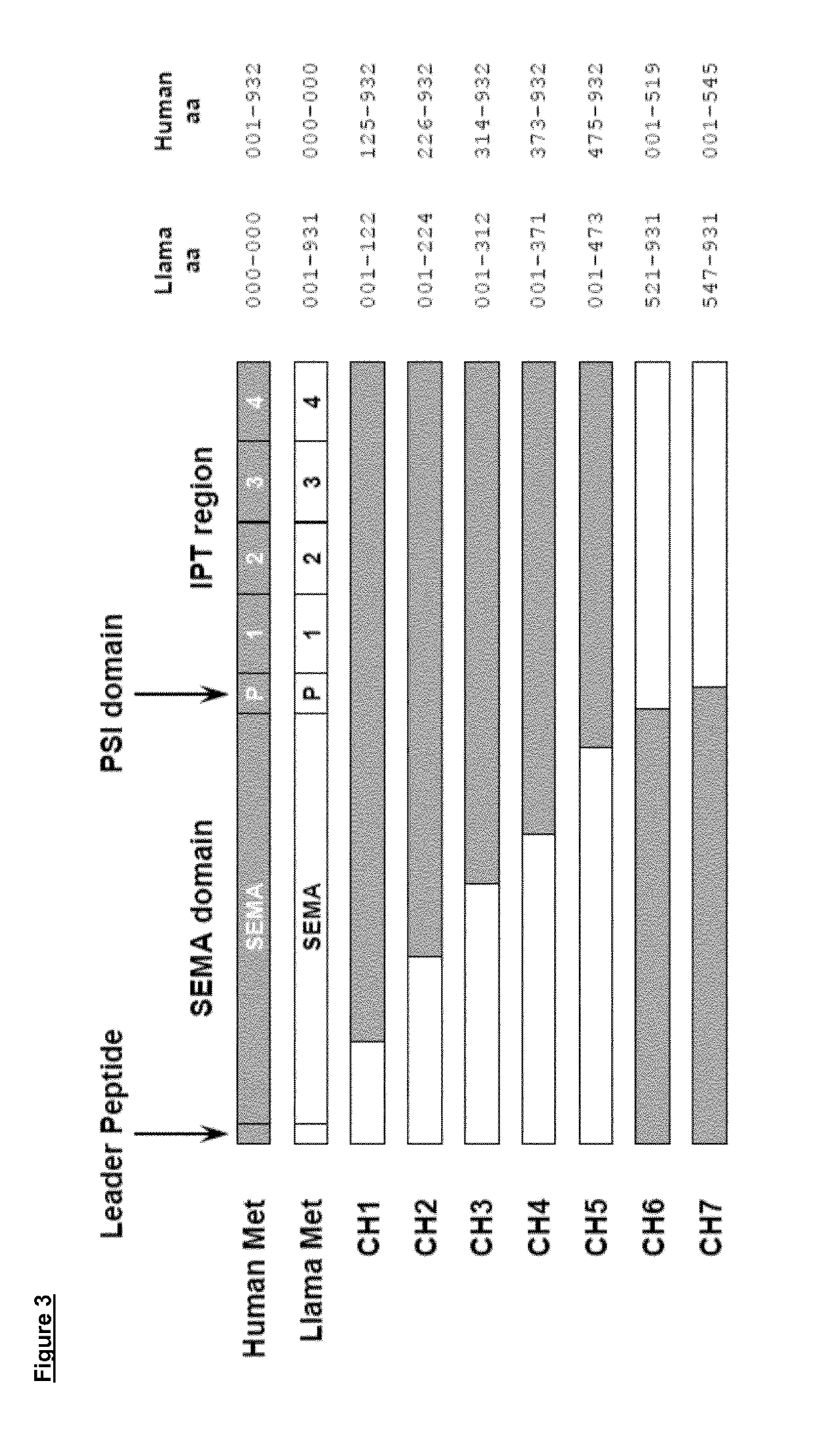Anti-met antibodies and uses thereof
a technology of anti-met antibodies and antibodies, which is applied in the field of anti-met antibodies and antigen binding fragments, can solve the problems of insufficient cross-reactivity of prior art anti-met antibodies and the generation of antibodies, and achieve superior binding to mouse met, preserve renal function and kidney integrity, and high affinity
- Summary
- Abstract
- Description
- Claims
- Application Information
AI Technical Summary
Benefits of technology
Problems solved by technology
Method used
Image
Examples
example 1
ion of Llamas
[0234]Immunizations of llamas and harvesting of peripheral blood lymphocytes (PBLs) as well as the subsequent extraction of RNA and amplification of antibody fragments were performed as described (De Haard et al., J. Bact. 187:4531-4541, 2005). Two adult llamas (Lama glama) were immunized by intramuscular injection of a chimeric protein consisting of the extracellular domain (ECD) of human MET fused to the Fc portion of human IgG1 (MET-Fc; R&D Systems). Each llama received one injection per week for six weeks, for a total of six injections. Each injection consisted in 0.2 mg protein in Freund's Incomplete Adjuvant in the neck divided over two spots.
[0235]Blood samples of 10 ml were collected pre- and post-immunization to investigate the immune response. Approximately one week after the last immunization, 400 ml of blood was collected and PBLs were obtained using the Ficoll-Paque method. Total RNA was extracted by the phenol-guanidine thiocyanate method (Chomczynski et a...
example 2
s and Screenings of Fabs Binding to Both Human and Mouse MET
[0237]Fab-expressing phages from the libraries described above were produced according to standard phage display protocols. For selection, phages were first adsorbed to immobilized recombinant human MET ECD, washed, and then eluted using trypsin. After two cycles of selection with human MET ECD, two other cycles were performed in the same fashion using mouse MET ECD. In parallel, we also selected phages alternating a human MET ECD cycle with a mouse MET ECD cycle, for a total of four cycles. Phages selected by the two approaches were pooled together and then used to infect TG1 E. coli. Individual colonies were isolated and secretion of Fabs was induced using IPTG (Fermentas). The Fab-containing periplasmic fraction of bacteria was collected and tested for its ability to bind human and mouse MET ECD by Surface Plasmon Resonance (SPR). Human or mouse MET ECD was immobilized on a CM-5 chip using amine coupling in sodium acetat...
example 3
tion of Fabs into mAbs
[0240]The cDNAs encoding the VH and VL (K or A) domains of selected Fab fragments were engineered into two separate pUPE mammalian expression vectors (U-protein Express) containing the cDNAs encoding CH1, CH2 and CH3 of human IgG1 or the human CL (κ or λ), respectively. The full amino acid sequences of llama-human chimeric antibody heavy chain and light chain is shown in Table 8.
TABLE 8Full heavy chain and light chain amino acid sequences of llama-human chimeric mAbs binding to bothhuman and mouse MET.SEQSEQIDIDCloneHeavy chain (VH-CH1-CH2-CH3)NO.Light chain (VL-CL)NO.76H10QLQLVESGGGLVQPGGSLRVSCTASGFTFNTYYMTWVRQAPGKGLEWV199QAVVTQEPSLSVSPGGTVTLTCGLSSGSVTTSN200SDINSGGGTYYADSVKGRFTISRDNAKNTLYLQMNSLKPEDTALYYCVYPGWFQQTPGQAPRTLIYNTNNRHSGVPSRFSGRVRIWPVGYDYWGQGTQVTVSSASTKGPSVFPLAPSSKSTSGGTAALGSISGNKAALTITGAQPEDEADYYCSLYTGSYTTCLVKDYFPEPVTVSWNSGALTSGVHTFPAVLQSSGLYSLSSVVTVPSSVFGGGTHLTVLQPKAAPSVTLFPPSSEELQANKSLGTQTYICNVNHKPSNTKVDKKVEPKSCDKTHTCPPCPAPELLGGPSATLVCLISDFYPGAVTV...
PUM
| Property | Measurement | Unit |
|---|---|---|
| flow rate | aaaaa | aaaaa |
| concentration | aaaaa | aaaaa |
| concentration | aaaaa | aaaaa |
Abstract
Description
Claims
Application Information
 Login to View More
Login to View More - R&D
- Intellectual Property
- Life Sciences
- Materials
- Tech Scout
- Unparalleled Data Quality
- Higher Quality Content
- 60% Fewer Hallucinations
Browse by: Latest US Patents, China's latest patents, Technical Efficacy Thesaurus, Application Domain, Technology Topic, Popular Technical Reports.
© 2025 PatSnap. All rights reserved.Legal|Privacy policy|Modern Slavery Act Transparency Statement|Sitemap|About US| Contact US: help@patsnap.com



